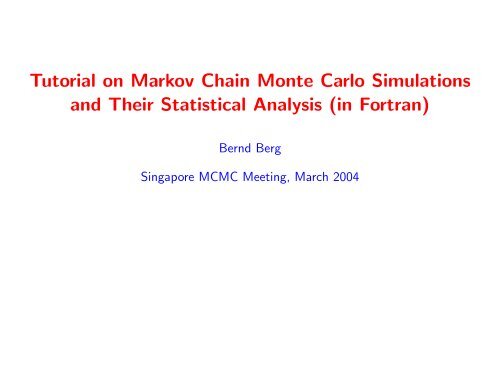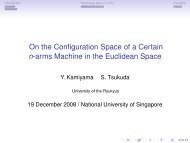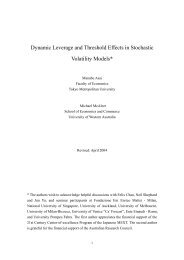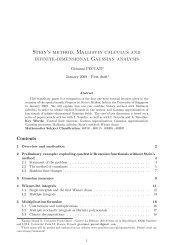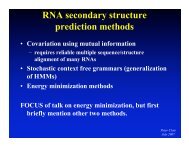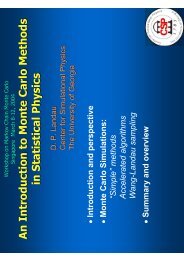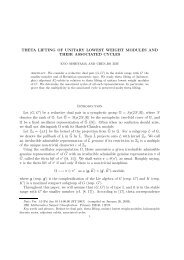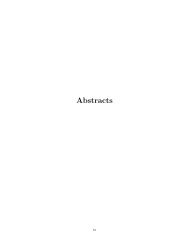Tutorial on Markov Chain Monte Carlo Simulations and Their ...
Tutorial on Markov Chain Monte Carlo Simulations and Their ...
Tutorial on Markov Chain Monte Carlo Simulations and Their ...
Create successful ePaper yourself
Turn your PDF publications into a flip-book with our unique Google optimized e-Paper software.
<str<strong>on</strong>g>Tutorial</str<strong>on</strong>g> <strong>on</strong> <strong>Markov</strong> <strong>Chain</strong> M<strong>on</strong>te <strong>Carlo</strong> Simulati<strong>on</strong>s<br />
<strong>and</strong> <strong>Their</strong> Statistical Analysis (in Fortran)<br />
Bernd Berg<br />
Singapore MCMC Meeting, March 2004
Overview<br />
1. Lecture I/II: Statistics as Needed.<br />
2. Lecture II: <strong>Markov</strong> <strong>Chain</strong> M<strong>on</strong>te <strong>Carlo</strong> (MC).<br />
3. Lecture III: Statistical Analysis of MC Data.<br />
4. Lecture IV: Multican<strong>on</strong>ical Simulati<strong>on</strong>s.<br />
1
Reference<br />
<strong>Markov</strong> <strong>Chain</strong> M<strong>on</strong>te <strong>Carlo</strong> Simulati<strong>on</strong>s <strong>and</strong> <strong>Their</strong><br />
Statistical Analysis I (with web-based Fortran code)<br />
by<br />
Bernd A. Berg<br />
To be published by World Scientific.<br />
2
C<strong>on</strong>tents of Lecture I<br />
1. Probability Distributi<strong>on</strong>s <strong>and</strong> Sampling<br />
2. R<strong>and</strong>om Numbers <strong>and</strong> the Fortran Code<br />
3. Gaussian Distributi<strong>on</strong>, C<strong>on</strong>fidence Intervals <strong>and</strong> Heapsort<br />
4. The Central Limit Theorem <strong>and</strong> Binning<br />
5. Gaussian Error Analysis for Large <strong>and</strong> Small Samples<br />
6. χ 2 Distributi<strong>on</strong>, the Error of the Error Bar, <strong>and</strong> the Variance Ratio Test<br />
7. The Jackknife Approach<br />
3
Probability Distributi<strong>on</strong>s <strong>and</strong> Sampling<br />
Probability or chance is <strong>on</strong>e of those basic c<strong>on</strong>cepts in science which elude a<br />
derivati<strong>on</strong> from more fundamental principles.<br />
A sample space is a set of events, also called measurements or observati<strong>on</strong>s,<br />
whose occurrence depends <strong>on</strong> chance.<br />
Carrying out independent repetiti<strong>on</strong>s of the same experiment is called sampling.<br />
The outcome of each experiment provides an event called data point. In N such<br />
experiments we may find the event A to occur with frequency n, 0 ≤ n ≤ N. The<br />
probability assigned to the event A is a number P (A), 0 ≤ P (A) ≤ 1, so that<br />
P (A) =<br />
lim<br />
N→∞<br />
n<br />
N . (1)<br />
This equati<strong>on</strong> is sometimes called the frequency definiti<strong>on</strong> of probability.<br />
Let us denote by P (a, b) the probability that x r ∈ [a, b] where x r is a r<strong>and</strong>om<br />
variable drawn in the interval (−∞, +∞) with the probability density f(x).<br />
4
Then,<br />
P (a, b) =<br />
∫ b<br />
Knowledge of all probabilities P (a, b) implies<br />
a<br />
f(x) dx. (2)<br />
f(x) = lim<br />
y→x − P (y, x)<br />
x − y<br />
≥ 0 . (3)<br />
The (cumulative) distributi<strong>on</strong> functi<strong>on</strong> of the r<strong>and</strong>om variable x r is defined as<br />
F (x) = P (x r ≤ x) =<br />
∫ x<br />
−∞<br />
f(x) dx . (4)<br />
A particularly important case is the uniform probability distributi<strong>on</strong> for r<strong>and</strong>om<br />
numbers between [0, 1),<br />
u(x) =<br />
{ 1 for 0 ≤ x < 1;<br />
0 elsewhere.<br />
(5)<br />
5
The corresp<strong>on</strong>ding distributi<strong>on</strong> functi<strong>on</strong> is<br />
U(x) =<br />
∫ x<br />
−∞<br />
u(x) dx =<br />
{ 0 for x < 0;<br />
x for 0 ≤ x ≤ 1;<br />
1 for x > 1.<br />
(6)<br />
Remarkably, the uniform distributi<strong>on</strong> allows for the c<strong>on</strong>structi<strong>on</strong> of general<br />
probability distributi<strong>on</strong>s. Let<br />
y = F (x) =<br />
∫ x<br />
−∞<br />
f(x ′ ) dx ′<br />
<strong>and</strong> assume that inverse x = F −1 (y) exist. For y r being a uniformly distributed<br />
r<strong>and</strong>om variable in the range [0, 1) it follows that<br />
x r = F −1 (y r ) (7)<br />
is distributed according to the probability density f(x).<br />
6
An example is the Cauchy distributi<strong>on</strong><br />
f c (x) =<br />
α<br />
π (α 2 + x 2 ) <strong>and</strong> F c(x) =<br />
∫ x<br />
−∞<br />
f c (x ′ ) dx ′ = 1 2 + 1 ( x<br />
)<br />
π tan−1 , α > 0 .<br />
α<br />
(8)<br />
The Cauchy distributed r<strong>and</strong>om variable x r is generated from the uniform y r ∈ [0, 1)<br />
through<br />
x r = α tan(2πy r ) . (9)<br />
1<br />
0.8<br />
Uniform y r<br />
0.6<br />
0.4<br />
0.2<br />
0<br />
-10 -5 0 5 10<br />
Cauchy x r<br />
Figure 1: Mapping of the uniform to the Cauchy distributi<strong>on</strong>.<br />
7
R<strong>and</strong>om Numbers <strong>and</strong> Fortran Code<br />
According to Marsaglia <strong>and</strong> collaborators a list of desirable properties for r<strong>and</strong>om<br />
number generators is:<br />
(i) R<strong>and</strong>omness. The generator should pass stringent tests for r<strong>and</strong>omness.<br />
(ii) L<strong>on</strong>g period.<br />
(iii) Computati<strong>on</strong>al efficiency.<br />
(iv) Repeatability. Initial c<strong>on</strong>diti<strong>on</strong>s (seed values) completely determine the<br />
resulting sequence of r<strong>and</strong>om variables.<br />
(v) Portability. Identical sequences of r<strong>and</strong>om variables may be produced <strong>on</strong> a<br />
wide variety of computers (for given seed values).<br />
(vi) Homogeneity. All subsets of bits of the numbers are r<strong>and</strong>om.<br />
8
Physicists have added a number of their applicati<strong>on</strong>s as new tests. In particular<br />
the exact soluti<strong>on</strong> of the 2d Ising model is used. Here the r<strong>and</strong>om number<br />
generator by Marsaglia <strong>and</strong> collaborators is provided. It relies <strong>on</strong> a combinati<strong>on</strong> of<br />
two generators:<br />
x n from a lagged Fib<strong>on</strong>acci series I n = I n−r − I n−s mod 2 24 , r = 97, s = 33.<br />
y n from the arithmetic series I − k, I − 2k, I − 3k, . . . , mod [2 24 − 3].<br />
For most applicati<strong>on</strong>s this generator is a good compromise. Our Fortran code<br />
which implements Marsaglia r<strong>and</strong>om numbers c<strong>on</strong>sists of three subroutines:<br />
rmaset.f to set the initial state of the r<strong>and</strong>om number generator.<br />
ranmar.f which provides <strong>on</strong>e r<strong>and</strong>om number per call.<br />
rmasave.f to save the final state of the generator.<br />
9
In additi<strong>on</strong>, rmafun.f is a functi<strong>on</strong> versi<strong>on</strong> of ranmar.f <strong>and</strong> calls to these two<br />
routines are freely interchangeable. Related is also the subroutine rmacau.f, which<br />
generates Cauchy r<strong>and</strong>om numbers with α = 1.<br />
The subroutine rmaset.f initializes the generator to mutually independent<br />
sequences of r<strong>and</strong>om numbers for distinct pairs of<br />
−1801 ≤ iseed1 ≤ 29527 <strong>and</strong> − 9373 ≤ iseed2 ≤ 20708 . (10)<br />
This property makes the generator quite useful for parallel processing.<br />
Table 1: Illustrati<strong>on</strong> of a start <strong>and</strong> a c<strong>on</strong>tinuati<strong>on</strong>s run of the Marsaglia r<strong>and</strong>om<br />
number generator using the program mar.f with the default seeds (a0102 02).<br />
RANMAR INITIALIZED.<br />
MARSAGLIA CONTINUATION.<br />
idat, xr = 1 0.116391063 idat, xr = 1 0.495856345<br />
idat, xr = 2 0.96484679 idat, xr = 2 0.577386141<br />
idat, xr = 3 0.882970393 idat, xr = 3 0.942340136<br />
idat, xr = 4 0.420486867 idat, xr = 4 0.243162394<br />
extra xr = 0.495856345 extra xr = 0.550126791<br />
10
How to run <strong>and</strong> get the FORTRAN code?<br />
STMC<br />
Assignments ForLib ForProg ForProc Work<br />
a0102_02 a0102_03 ... ... a0103_01 ... ...<br />
Figure 2: The Fortran routines are provided <strong>and</strong> prepared to run in the a tree structure of folders<br />
depicted in this figure. This tree of directories unfolds from the downloaded file.<br />
To download the Fortran code book visit the website<br />
<strong>and</strong> follow the instructi<strong>on</strong>s given there.<br />
http : //b berg.home.comcast.net/<br />
11
The code is provided in the directories ForLib, ForProg <strong>and</strong> ForProc. ForLib<br />
c<strong>on</strong>tains a library of functi<strong>on</strong>s <strong>and</strong> subroutines which is closed in the sense that<br />
no reference to n<strong>on</strong>-st<strong>and</strong>ard functi<strong>on</strong>s or subroutines outside the library is ever<br />
made. Fortran programs are c<strong>on</strong>tained in the folder ForProg <strong>and</strong> procedures for<br />
interactive use in ForProc.<br />
Assignment: Marsaglia r<strong>and</strong>om numbers. Run the program mar.f to<br />
reproduce the results of table 1. Underst<strong>and</strong> how to re-start the r<strong>and</strong>om number<br />
generator as well as how to perform different starts when the c<strong>on</strong>tinuati<strong>on</strong> data<br />
file ranmar.d does not exist. Note: You find mar.f in ForProg/Marsaglia<br />
<strong>and</strong> it includes subroutines from ForLib. To compile properly, mar.f has to be<br />
located two levels down from a root directory STMC. The soluti<strong>on</strong> is found in the<br />
subdirectory Assignments/a0102 02.<br />
The hyperstructure of program dependencies introduced between the levels<br />
of the STMC directory tree should be kept!<br />
12
Gaussian Distributi<strong>on</strong><br />
The Gaussian or normal distributi<strong>on</strong> is of major importance. Its probability<br />
density is<br />
g(x) = 1<br />
σ √ 2π e−x2 /(2σ 2 )<br />
(11)<br />
where σ 2 is the variance <strong>and</strong> σ > 0 the st<strong>and</strong>ard deviati<strong>on</strong>. The Gaussian<br />
distributi<strong>on</strong> functi<strong>on</strong> G(x) is related to that of variance σ 2 = 1 by<br />
G(x) =<br />
∫ x<br />
−∞<br />
g(x ′ ) dx ′ = 1 √<br />
2π<br />
∫ x/σ<br />
−∞<br />
e −(x′′ ) 2 /2 dx ′′ = 1 2 + 1 ( ) x<br />
2 erf σ √ 2<br />
. (12)<br />
In principle we could now generate Gaussian r<strong>and</strong>om numbers. However, the<br />
numerical calculati<strong>on</strong> of the inverse error functi<strong>on</strong> is slow <strong>and</strong> makes this an<br />
impractical procedure. Much faster is to express the product probability density of<br />
13
two independent Gaussian distributi<strong>on</strong>s in polar coordinates<br />
1<br />
2π σ 2 e−x2 /(2σ 2) e −y2 /(2σ 2) dx dy = 1<br />
2π σ 2 e−r2 /(2σ 2) dφ rdr ,<br />
<strong>and</strong> to use the relati<strong>on</strong>s<br />
x r = r r cos φ r <strong>and</strong> y r = r r sin φ r . (13)<br />
1<br />
0.8<br />
Uniform<br />
Gaussian<br />
Cauchy<br />
0.6<br />
F<br />
0.4<br />
0.2<br />
0<br />
-3 -2 -1 0 1 2 3<br />
x<br />
Figure 3: Cumulative distributi<strong>on</strong> functi<strong>on</strong>s for a uniform, a Gaussian <strong>and</strong> a Cauchy distributi<strong>on</strong><br />
(Assignment a0101 02).<br />
14
C<strong>on</strong>fidence Intervals <strong>and</strong> Heapsort<br />
Let a distributi<strong>on</strong> functi<strong>on</strong> F (x) <strong>and</strong> 0 ≤ q ≤ 1 be given. One defines q-tiles<br />
(also called quantiles or fractiles) x q by means of<br />
F (x q ) = q . (14)<br />
The median x1<br />
2<br />
is often the typical value of the r<strong>and</strong>om variable x r .<br />
The precise probability c<strong>on</strong>tent of the c<strong>on</strong>fidence intervals<br />
[x q , x 1−q ] = [−nσ, nσ] for n = 1, 2<br />
of the normal distributi<strong>on</strong> is p = 68.27% for <strong>on</strong>e σ <strong>and</strong> p = 95.45% for two σ.<br />
The peaked distributi<strong>on</strong> functi<strong>on</strong><br />
F q (x) =<br />
{<br />
F (x) for F (x) ≤<br />
1<br />
2 ,<br />
1 − F (x) for F (x) > 1 2 . (15)<br />
15
provides a useful way to visualize probability intervals of a distributi<strong>on</strong>.<br />
0.5<br />
Gaussian F q (x)=gau - qdf(x)<br />
0.4<br />
Fq<br />
0.3<br />
0.2<br />
0.1<br />
0<br />
-3 -2 -1 0 1 2 3<br />
x<br />
Figure 4: Gaussian peaked distributi<strong>on</strong> functi<strong>on</strong> <strong>and</strong> estimates of x q for the 70% (approximately<br />
1 σ) <strong>and</strong> 95% (approximately 2 σ) c<strong>on</strong>fidence intervals.<br />
Sampling provides us with an empirical distributi<strong>on</strong> functi<strong>on</strong> <strong>and</strong> in practice the<br />
problem is to estimate c<strong>on</strong>fidence intervals from the empirical data.<br />
Assume we generate n r<strong>and</strong>om number x 1 , ..., x n according to a probability<br />
distributi<strong>on</strong> F (x). The n r<strong>and</strong>om numbers c<strong>on</strong>stitute then a sample.<br />
16
We may re-arrange the x i in increasing order. Denoting the smallest value by<br />
x π1 , the next smallest by x π2 , etc., we arrive at<br />
x π1 ≤ x π2 ≤ . . . ≤ x πn (16)<br />
where π 1 , . . . , π n is a permutati<strong>on</strong> of 1, . . . , n. Each of the x πi is then called<br />
an order statistic. An estimator for the distributi<strong>on</strong> functi<strong>on</strong> F (x) is then the<br />
empirical distributi<strong>on</strong> functi<strong>on</strong><br />
F (x) = i n for x π i<br />
≤ x < x πi+1 , i = 0, 1, . . . , n − 1, n (17)<br />
with the definiti<strong>on</strong>s x π0 = −∞ <strong>and</strong> x πn+1 = +∞.<br />
To calculate F (x) <strong>and</strong> the corresp<strong>on</strong>ding peaked distributi<strong>on</strong> functi<strong>on</strong>, <strong>on</strong>e<br />
needs an efficient way to sort n data values in ascending (or descending) order.<br />
This is provided by the heapsort, which relies <strong>on</strong> two steps: First the data are<br />
arranged in a heap, then the heap is sorted.<br />
17
A heap is a partial ordering so that the number at the top is larger or equal<br />
than the two numbers in the sec<strong>on</strong>d row, provided at least three numbers x i exist.<br />
Each number of the sec<strong>on</strong>d row has under it two smaller or equal numbers in the<br />
third row <strong>and</strong> so <strong>on</strong>, until all numbers x i , . . . , x n are exhausted. Example:<br />
Table 2: The heap, generated from Marsaglia’s first ten r<strong>and</strong>om numbers.<br />
.9648<br />
.6892 .9423<br />
.5501 .4959 .5774 .8830<br />
.2432 .4205 .1164<br />
Finally, the heap is sorted. The computer time needed to succeed with the<br />
sorting process grows <strong>on</strong>ly like n log 2 n because there are log 2 n levels in the heap,<br />
see Knuth for a detailed discussi<strong>on</strong> of sorting algorithms.<br />
18
Example:<br />
1<br />
0.8<br />
Empirical F <strong>and</strong> F q<br />
Exact F <strong>and</strong> F q<br />
F <strong>and</strong> F q<br />
0.6<br />
0.4<br />
0.2<br />
0<br />
0 0.2 0.4 0.6 0.8 1<br />
x<br />
Figure 5: Cumulative <strong>and</strong> peaked distributi<strong>on</strong> functi<strong>on</strong>s for Marsaglia’s first 100 uniform r<strong>and</strong>om<br />
numbers (assignment a0106 02).<br />
19
The Central Limit Theorem <strong>and</strong> Binning<br />
How is the sum of two independent r<strong>and</strong>om variables<br />
y r = x r 1 + x r 2 . (18)<br />
distributed? We denote the probability density of y r by g(y). The corresp<strong>on</strong>ding<br />
cumulative distributi<strong>on</strong> functi<strong>on</strong> is given by<br />
G(y) =<br />
∫<br />
x 1 +x 2 ≤y<br />
f 1 (x 1 ) f 2 (x 2 ) dx 1 dx 2 ==<br />
∫ +∞<br />
−∞<br />
f 1 (x) F 2 (y − x) dx<br />
where F 2 (x) is the distributi<strong>on</strong> functi<strong>on</strong> of the r<strong>and</strong>om variable x r 2. We take the<br />
derivative <strong>and</strong> obtain the probability density of y r<br />
g(y) = dG(y)<br />
dy<br />
=<br />
∫ +∞<br />
−∞<br />
f 1 (x) f 2 (y − x) dx . (19)<br />
20
The probability density of a sum of two independent r<strong>and</strong>om variables is the<br />
c<strong>on</strong>voluti<strong>on</strong> of the probability densities of these r<strong>and</strong>om variables.<br />
Example: Sums of uniform r<strong>and</strong>om numbers, corresp<strong>on</strong>ding to the sums of an<br />
uniformly distributed r<strong>and</strong>om variable x r ∈ (0, 1]:<br />
(a) Let y r = x r + x r , then<br />
g 2 (y) =<br />
{ y for 0 ≤ y ≤ 1,<br />
2 − y for 1 ≤ y ≤ 2,<br />
0 elsewhere.<br />
(20)<br />
(b) Let y r = x r + x r + x r , then<br />
g 3 (y) =<br />
⎧<br />
⎪⎨<br />
y 2 /2 for 0 ≤ y ≤ 1,<br />
(−2y 2 + 6y − 3)/2 for 1 ≤ y ≤ 2,<br />
⎪⎩ (y − 3) 2 /2 for 2 ≤ y ≤ 3,<br />
0 elsewhere.<br />
(21)<br />
21
The c<strong>on</strong>voluti<strong>on</strong> (19) takes <strong>on</strong> a simple form in Fourier space. In statistics<br />
the Fourier transformati<strong>on</strong> of the probability density is known as characteristic<br />
functi<strong>on</strong>, defined as the expectati<strong>on</strong> value of e itxr :<br />
φ(t) = 〈e itxr 〉 =<br />
∫ +∞<br />
−∞<br />
e itx f(x) dx . (22)<br />
The characteristic functi<strong>on</strong> is particularly useful for investigating sums of r<strong>and</strong>om<br />
variables, y r = x r 1 + x r 2:<br />
φ y (t) = 〈e (itxr 1 +itxr 2 ) 〉 =<br />
∫ +∞ ∫ +∞<br />
−∞<br />
−∞<br />
e itx e ity f 1 (x 1 ) f 2 (x 2 ) dx 1 dx 2 = φ x1 (t) φ x2 (t) .<br />
(23)<br />
The characteristic functi<strong>on</strong> of a sum of r<strong>and</strong>om variables is the product of<br />
their characteristic functi<strong>on</strong>s. The result generalizes immediately to N r<strong>and</strong>om<br />
variables<br />
y r = x r 1 + . . . + x r N . (24)<br />
22
The characteristic functi<strong>on</strong> of y r is<br />
φ y (t) =<br />
N∏<br />
φ xi (t) (25)<br />
i=1<br />
<strong>and</strong> the probability density of y r<br />
characteristic functi<strong>on</strong><br />
is the Fourier back-transformati<strong>on</strong> of this<br />
g(y) = 1<br />
2π<br />
∫ +∞<br />
−∞<br />
dt e −ity φ y (t) . (26)<br />
The probability density of the sample mean is obtained as follows: The<br />
arithmetic mean of y r is x r = y r /N. We denote the probability density of y r<br />
by g N (y) <strong>and</strong> the probability density of the arithmetic mean by ĝ N (x). They are<br />
related by<br />
ĝ N (x) = N g N (Nx) . (27)<br />
23
This follows by substituting y = Nx into g N (y) dy:<br />
∫ +∞<br />
∫ +∞<br />
∫ +∞<br />
1 =<br />
−∞<br />
g N (y) dy =<br />
−∞<br />
g N (Nx) 2dx =<br />
−∞<br />
ĝ N (x) dx .<br />
Example:<br />
2.5<br />
2<br />
g 2 (x)<br />
g 3 (x)<br />
1.5<br />
g<br />
1<br />
0.5<br />
0<br />
0 0.2 0.4 0.6 0.8 1<br />
x<br />
Figure 6: Probability densities for the arithmetic means of two <strong>and</strong> three uniformly distributed<br />
r<strong>and</strong>om variables, ĝ 2 (x) <strong>and</strong> ĝ 3 (x), respectively.<br />
24
This suggests that sampling leads to c<strong>on</strong>vergence of the mean by reducing its<br />
variance. We use the characteristic functi<strong>on</strong> to underst<strong>and</strong> the general behavior.<br />
The characteristic functi<strong>on</strong> of a sum of independent r<strong>and</strong>om variables is the product<br />
of their individual characteristic functi<strong>on</strong>s<br />
φ y (t) = [φ x (t)] N . (28)<br />
The characteristic functi<strong>on</strong> for the corresp<strong>on</strong>ding arithmetic average is<br />
Hence,<br />
φ x (t) =<br />
∫ +∞<br />
−∞<br />
=<br />
dx e itx ĝ N (x) =<br />
∫ +∞<br />
−∞<br />
φ x (t) = φ y<br />
( t<br />
N<br />
∫ +∞<br />
−∞<br />
dy exp<br />
(i t )<br />
N y<br />
)<br />
=<br />
Ndx e itx g N (Nx)<br />
g N (y) .<br />
[<br />
φ x<br />
( t<br />
N<br />
)] N<br />
. (29)<br />
25
Example: The normal distributi<strong>on</strong>.<br />
The characteristic functi<strong>on</strong> is obtained by Gaussian integrati<strong>on</strong><br />
φ(t) = exp<br />
(− 1 )<br />
2 σ2 t 2 . (30)<br />
Defining y r = x r + x r we have<br />
φ y (t) = [φ(t)] 2<br />
= exp<br />
(− 1 )<br />
2 2σ2 t 2<br />
. (31)<br />
This is the characteristic functi<strong>on</strong> of a Gaussian with variance 2σ 2 . We obtain<br />
the characteristic functi<strong>on</strong> of the arithmetic average x r = y r /2 by the substituti<strong>on</strong><br />
t → t/2:<br />
(<br />
φ x (t) = exp − 1 σ 2 )<br />
2 2 t2 . (32)<br />
The variance is reduced by a factor of two.<br />
26
The Central Limit Theorem<br />
To simplify the equati<strong>on</strong>s we restrict ourselves to ̂x = 0. Let us c<strong>on</strong>sider a<br />
probability density f(x) <strong>and</strong> assume that its moment exists, implying that the<br />
characteristic functi<strong>on</strong> is a least two times differentiable, so that<br />
φ x (t) = 1 − σ2 x<br />
2 t2 + O(t 3 ) . (33)<br />
The leading term reflects the the normalizati<strong>on</strong> of the probability density <strong>and</strong> the<br />
first moment is φ ′ (0) = ̂x = 0. The characteristic functi<strong>on</strong> of the mean becomes<br />
φ x (t) =<br />
[<br />
1 − σ2 x<br />
2N 2t2<br />
+ O<br />
( t<br />
3<br />
N 3 )] N<br />
= exp<br />
[<br />
− 1 2<br />
σx<br />
2 ]<br />
N t2<br />
+ O<br />
( t<br />
3<br />
N 2 )<br />
.<br />
The probability density of the arithmetic mean x r c<strong>on</strong>verges towards the<br />
Gaussian probability density with variance<br />
σ 2 (x r ) = σ2 (x r )<br />
N . (34)<br />
27
A Counter example: The Cauchy distributi<strong>on</strong> provides an instructive, case<br />
for which the central limit theorem does not work. This is expected as its sec<strong>on</strong>d<br />
moment does not exist. Nevertheless, the characteristic functi<strong>on</strong> of the Cauchy<br />
distributi<strong>on</strong> exists. For simplicity we take α = 1 <strong>and</strong> get<br />
φ(t) =<br />
∫ +∞<br />
−∞<br />
dx<br />
e itx<br />
π (1 + x 2 )<br />
= exp(−|t|) . (35)<br />
The integrati<strong>on</strong> involves the residue theorem. Using equati<strong>on</strong> (29) for the<br />
characteristic functi<strong>on</strong> of the mean of N r<strong>and</strong>om variables, we find<br />
φ x (t) =<br />
[ (<br />
exp − |t| )] n<br />
= exp(−|t|) . (36)<br />
N<br />
The surprisingly simple result is that the probability distributi<strong>on</strong> for the mean values<br />
of N independent Cauchy r<strong>and</strong>om variables agrees with the probability distributi<strong>on</strong><br />
of a single Cauchy r<strong>and</strong>om variable. Estimates of the Cauchy mean cannot be<br />
obtained by sampling. Indeed, the mean does not exist.<br />
28
Binning<br />
The noti<strong>on</strong> of introduced here should not be c<strong>on</strong>fused with histogramming!<br />
Binning means here that we group NDAT data into NBINS bins, where each binned<br />
data point is the arithmetic average of<br />
NBIN = [NDAT/NBINS] (Fortran integer divisi<strong>on</strong>.)<br />
original data points. Preferably NDAT is a multiple of NBINS. The purpose of the<br />
binning procedure is twofold:<br />
1. When the the central limit theorem applies, the binned data will become<br />
practically Gaussian, as so<strong>on</strong> as NBIN becomes large enough. This allows to<br />
apply Gaussian error analysis methods even when the original are not Gaussian.<br />
2. When data are generated by a <strong>Markov</strong> process subsequent events are correlated.<br />
For binned data these correlati<strong>on</strong>s are reduced <strong>and</strong> can in practical applicati<strong>on</strong>s be<br />
neglected, <strong>on</strong>ce NBIN is sufficiently large when compared to the autocorrelati<strong>on</strong><br />
time,<br />
29
Example:<br />
7<br />
6<br />
Normal distributi<strong>on</strong><br />
Binned data<br />
5<br />
4<br />
H<br />
3<br />
Figure 7:<br />
2<br />
1<br />
0<br />
0.25 0.3 0.35 0.4 0.45 0.5 0.55 0.6 0.65 0.7 0.75<br />
Comparis<strong>on</strong> of a histogram of 500 binned data with the normal distributi<strong>on</strong><br />
√<br />
(120/π) exp[−120 (x − 1/2) 2 ]. Each binned data point is the average of 20 uniformly<br />
distributed r<strong>and</strong>om numbers. Assignment a0108 02.<br />
x r<br />
30
Gaussian Error Analysis for Large <strong>and</strong> Small Samples<br />
The central limit theorem underlines the importance of the normal distributi<strong>on</strong>.<br />
Assuming we have a large enough sample, the arithmetic mean of a suitable<br />
expectati<strong>on</strong> value becomes normally distributed <strong>and</strong> the calculati<strong>on</strong> of the c<strong>on</strong>fidence<br />
intervals is reduced to studying the normal distributi<strong>on</strong>. It has become the<br />
c<strong>on</strong>venti<strong>on</strong> to use the st<strong>and</strong>ard deviati<strong>on</strong> of the sample mean<br />
σ = σ(x r ) with x r =<br />
N∑<br />
x r i (37)<br />
i=1<br />
to indicate its c<strong>on</strong>fidence intervals [̂x − nσ, ̂x + nσ] (the dependence of σ <strong>on</strong> N<br />
is suppressed). For a Gaussian distributi<strong>on</strong> equati<strong>on</strong> (12) yields the probability<br />
c<strong>on</strong>tent p of the c<strong>on</strong>fidence intervals (37) to be<br />
p = p(n) = G(nσ) − G(−nσ) = 1 √<br />
2π<br />
∫ +n<br />
−n<br />
dx e −1 2 x2 = erf<br />
( n√2<br />
)<br />
. (38)<br />
31
Table 3: Probability c<strong>on</strong>tent p of Gaussian c<strong>on</strong>fidence intervals [̂x − nσ, ̂x + nσ],<br />
n = 1, . . . , 6, <strong>and</strong> q = (1 − p)/2. Assignment a0201 01.<br />
n 1 2 3 4 5<br />
p .68 .95 1.0 1.0 1.0<br />
q .16 .23E-01 .13E-02 .32E-04 .29E-06<br />
In practice the roles of x <strong>and</strong> ̂x are interchanged: One would like to know<br />
the likelihood that the unknown exact expectati<strong>on</strong> value ̂x will be in a certain<br />
c<strong>on</strong>fidence interval around the measured sample mean. The relati<strong>on</strong>ship<br />
x ∈ [̂x − nσ, ̂x + nσ] ⇐⇒ ̂x ∈ [x − nσ, x + nσ] (39)<br />
solves the problem. C<strong>on</strong>venti<strong>on</strong>ally, these estimates are quoted as<br />
̂x = x ± △x (40)<br />
where the error bar △x is often an estimator of the exact st<strong>and</strong>ard deviati<strong>on</strong>.<br />
32
An obvious estimator for the variance σ 2 x is<br />
(s ′ r<br />
x ) 2 = 1 N<br />
N∑<br />
(x r i − x r ) 2 (41)<br />
i=1<br />
where the prime indicates that we shall not be happy with it, because we encounter<br />
a bias. An estimator is said to be biased when its expectati<strong>on</strong> value does not agree<br />
with the exact result. In our case<br />
〈(s ′ r<br />
x ) 2 〉 ≠ σ 2 x . (42)<br />
An estimator whose expectati<strong>on</strong> value agrees with the true expectati<strong>on</strong> value is<br />
called unbiased. For the variance it is rather straightforward to c<strong>on</strong>struct an<br />
unbiased estimator (s r x) x . The bias of the definiti<strong>on</strong> (41) comes from replacing the<br />
exact mean ̂x by its estimator x r . The latter is a r<strong>and</strong>om variable, whereas the<br />
former is just a number.<br />
33
Some algebra shows that the desired unbiased estimator of the variance is<br />
given by<br />
(s r x) 2 = N<br />
N − 1 (s′ x r ) 2 1<br />
N∑<br />
= (x r i − x r ) 2 . (43)<br />
N − 1<br />
Corresp<strong>on</strong>dingly, the unbiased estimator of the variance of the sample mean is<br />
i=1<br />
(s r x) 2 =<br />
1<br />
N(N − 1)<br />
N∑<br />
(x r i − x r ) 2 . (44)<br />
i=1<br />
Gaussian difference test:<br />
In practice <strong>on</strong>e is often faced with the problem to compare two different empirical<br />
estimates of some mean. How large must D = x − y be in order to indicate a real<br />
difference? The quotient<br />
d r<br />
= Dr<br />
σ D<br />
(45)<br />
34
is normally distributed with expectati<strong>on</strong> zero <strong>and</strong> variance <strong>on</strong>e, so that<br />
( ) d√2<br />
P = P (|d r | ≤ d) = G 0 (d) − G 0 (−d) = 1 − 2 G 0 (−d) = erf<br />
. (46)<br />
The likelihood that the observed difference |x − y| is due to chance is defined<br />
to be<br />
( ) d√2<br />
Q = 1 − P = 2 G 0 (−d) = 1 − erf . (47)<br />
If the assumpti<strong>on</strong> is correct, then Q is a uniformly distributed r<strong>and</strong>om variable in<br />
the range [0, 1). Examples are:<br />
Table 4: Gaussian difference tests (assignment a0201 06).<br />
x 1 ± σ x1 1.0 ± 0.1 1.0 ± 0.1 1.0 ± 0.1 1.0 ± 0.05 1.000 ± 0.025<br />
x 2 ± σ x2 1.2 ± 0.2 1.2 ± 0.1 1.2 ± 0.0 1.2 ± 0.00 1.200 ± 0.025<br />
Q 0.37 0.16 0.046 0.000063 0.15 × 10 −7 35
Gosset’s Student Distributi<strong>on</strong><br />
We ask the questi<strong>on</strong>: What happens with the Gaussian c<strong>on</strong>fidence limits when<br />
we replace the variance σx 2 by its estimator s2 x in statements like<br />
|x − ̂x|<br />
σ x<br />
< 1.96 with 95% probability.<br />
For sampling from a Gaussian distributi<strong>on</strong> the answer was given by Gosset, who<br />
published his article 1908 under the pseud<strong>on</strong>ym Student in Biometrika. He showed<br />
that the distributi<strong>on</strong> of the r<strong>and</strong>om variable<br />
t r = x r − ̂x<br />
s r x<br />
(48)<br />
is given by the probability density<br />
f(t) =<br />
1<br />
(N − 1) B(1/2, (N − 1)/2)<br />
) −<br />
N (1 + t2 2<br />
. (49)<br />
N − 1<br />
36
Here B(x, y) is the beta functi<strong>on</strong>. The fall-off is a power law |t| −f for |t| → ∞,<br />
instead of the exp<strong>on</strong>ential fall-off of the normal distributi<strong>on</strong>. C<strong>on</strong>fidence probabilities<br />
of the Student distributi<strong>on</strong> are:<br />
N \ S 1.0000 2.0000 3.0000 4.0000 5.0000<br />
2 .50000 .70483 .79517 .84404 .87433<br />
3 .57735 .81650 .90453 .94281 .96225<br />
4 .60900 .86067 .94233 .97199 .98461<br />
8 .64938 .91438 .98006 .99481 .99843<br />
16 .66683 .93605 .99103 .99884 .99984<br />
32 .67495 .94567 .99471 .99963 .99998<br />
64 .67886 .95018 .99614 .99983 1.0000<br />
INFINITY: .68269 .95450 .99730 .99994 1.0000<br />
For N ≤ 4 we find substantial deviati<strong>on</strong>s from the Gaussian c<strong>on</strong>fidence levels.<br />
Up to two st<strong>and</strong>ard deviati<strong>on</strong>s reas<strong>on</strong>able approximati<strong>on</strong>s of Gaussian c<strong>on</strong>fidence<br />
limits are obtained for N ≥ 16 data. If desired, the Student distributi<strong>on</strong> functi<strong>on</strong><br />
can always be used to calculate the exact c<strong>on</strong>fidence limits. When the central limit<br />
theorem applies, we can bin a large set of n<strong>on</strong>-Gaussian data into 16 almost<br />
Gaussian data <strong>and</strong> reduce the error analysis to Gaussian methods.<br />
37
Student difference test<br />
This test is a generalizati<strong>on</strong> of the Gaussian difference test. It takes into account<br />
that <strong>on</strong>ly a finite number of events are sampled. As before it is assumed that the<br />
events are drawn from a normal distributi<strong>on</strong>. Let the following data be given<br />
x calculated from M events, i.e., σ 2 x = σ 2 x/M (50)<br />
y calculated from N events, i.e., σ 2 y = σ 2 y/N (51)<br />
<strong>and</strong> an unbiased estimators of the variances<br />
s 2 x = s 2 x/M =<br />
∑ M<br />
i=1 (x i − x) 2<br />
M (M − 1)<br />
<strong>and</strong> s 2 y = s 2 y/N =<br />
∑ N<br />
j=1 (y j − y) 2<br />
N (N − 1)<br />
. (52)<br />
Under the additi<strong>on</strong>al assumpti<strong>on</strong> σx 2 = σy<br />
2 the discussi<strong>on</strong> which leads to the<br />
Student distributi<strong>on</strong> applies <strong>and</strong> the probability<br />
P (|x − y| > d) (53)<br />
38
is determined by the Student distributi<strong>on</strong> functi<strong>on</strong> in the same way as the probability<br />
of the Gaussian difference test is determined by the normal distributi<strong>on</strong>.<br />
Examples for the Student difference test for x 1 = 1.00 ± 0.05 from M data <strong>and</strong><br />
x 2 = 1.20 ± 0.05 from N data (assignment a0203 03):<br />
M 512 32 16 16 4 3 2<br />
N 512 32 16 4 4 3 2<br />
Q 0.0048 0.0063 0.0083 0.072 0.030 0.047 0.11<br />
The Gaussian difference test gives Q = 0.0047. For M = N = 512 the Student<br />
Q value is practically identical with the Gaussian result, for M = N = 16 it has<br />
almost doubled. Likelihoods above a 5% cut-off, are <strong>on</strong>ly obtained for M = N = 2<br />
(11%) <strong>and</strong> M = 16, N = 4 (7%). The latter result looks a bit surprising, because<br />
its Q value is smaller than for M = N = 4. The explanati<strong>on</strong> is that for M = 16,<br />
N = 4 data <strong>on</strong>e would expect the N = 4 error bar to be two times larger than the<br />
M = 16 error bar, whereas the estimated error bars are identical.<br />
This leads to the problem: Assume data are sampled from the same normal<br />
distributi<strong>on</strong>, when are two measured error bars c<strong>on</strong>sistent <strong>and</strong> when not?<br />
39
χ 2 Distributi<strong>on</strong>, Error of the Error Bar, Variance Ratio Test<br />
The distributi<strong>on</strong> of the r<strong>and</strong>om variable<br />
(χ r ) 2 =<br />
N∑<br />
(yi r ) 2 , (54)<br />
i=1<br />
where each y r i is normally distributed, defines the χ2 distributi<strong>on</strong> with N degrees<br />
of freedom. The study of the variance (s r x) 2 of a Gaussian sample can be reduced<br />
to the χ 2 -distributi<strong>on</strong> with f = N − 1 degrees of freedom<br />
(χ r f) 2 = (N − 1) (sr x) 2<br />
σ 2 x<br />
=<br />
N∑<br />
i=1<br />
(x r i − x r ) 2<br />
σ 2 x<br />
. (55)<br />
The probability density of χ 2 per degree of freedom (pdf) is<br />
f N (χ 2 ) = Nf(Nχ 2 ) = a e−aχ2<br />
(<br />
aχ<br />
2 ) a−1<br />
Γ(a)<br />
where a = N 2 . (56)<br />
40
For N = 1, 2, . . . , 20 this probability density is plotted in the figure <strong>and</strong> we can<br />
see the central limit theorem at work. Picking the curves at χ 2 /N = 1, increasing<br />
f N (χ 2 ) values corresp<strong>on</strong>d to increasing N = 1, 2, . . . , 20. Assignment a0202 03.<br />
1.4<br />
1.2<br />
1<br />
f N (χ 2 )<br />
0.8<br />
0.6<br />
0.4<br />
0.2<br />
0<br />
0 0.2 0.4 0.6 0.8 1 1.2 1.4 1.6 1.8 2<br />
χ 2 41
The Error of the Error Bar<br />
For normally distributed data the number of data al<strong>on</strong>e determines the errors<br />
of error bars, because the χ 2 distributi<strong>on</strong> is exactly known. One does not have to<br />
rely <strong>on</strong> estimators! C<strong>on</strong>fidence intervals for variance estimates s 2 x = 1 from NDAT<br />
data (assignment a0204 01):<br />
q q q 1-q 1-q<br />
NDAT=2**K .025 .150 .500 .850 .975<br />
2 1 .199 .483 2.198 27.960 1018.255<br />
4 2 .321 .564 1.268 3.760 13.902<br />
8 3 .437 .651 1.103 2.084 4.142<br />
16 4 .546 .728 1.046 1.579 2.395<br />
32 5 .643 .792 1.022 1.349 1.768<br />
1024 10 .919 .956 1.001 1.048 1.093<br />
16384 14 .979 .989 1.000 1.012 1.022<br />
42
Variance ratio test (F -test)<br />
We assume that two sets of( normal ) data are ( given) together with estimates<br />
of their variances σx 2 1<br />
<strong>and</strong> σx 2 2<br />
: s<br />
2<br />
x1<br />
, N 1 <strong>and</strong> s<br />
2<br />
x2<br />
, N 2 . We would like to test<br />
whether the ratio F = s2 x 1<br />
s 2 x 2<br />
differs from F = 1 in a statistically significant way. The<br />
probability f 1<br />
f 2<br />
F < w, where f i = N i − 1, i = 1, 2, is know to be<br />
Examples (assignment a0505 02):<br />
( 1<br />
H(w) = 1 − B I<br />
w + 1 , 1 2 f 2, 1 )<br />
2 f 1<br />
. (57)<br />
△x 1 1.0 1.0 1.0 1.0 1.0 1.0 1.0 1.0<br />
N 1 16 16 64 1024 2048 32 1024 16<br />
△x 2 1.0 1.0 1.0 1.05 1.05 2.0 2.0 2.0<br />
N 2 16 8 16 1024 2048 8 256 16<br />
Q 1.0 0.36 0.005 0.12 0.027 0.90 0.98 0.01<br />
This test allows us later to compare the efficiency of MC algorithms.<br />
43
The Jackknife Approach<br />
Jackknife estimators allow to correct for the bias <strong>and</strong> the error of the bias.<br />
The method was introduced in the 1950s in papers by Quenouille <strong>and</strong> Tukey. The<br />
jackknife method is recommended as the st<strong>and</strong>ard for error bar calculati<strong>on</strong>s. In<br />
unbiased situati<strong>on</strong>s the jackknife <strong>and</strong> the usual error bars agree. Otherwise the<br />
jackknife estimates are improvements, so that <strong>on</strong>e cannot loose.<br />
The unbiased estimator of the expectati<strong>on</strong> value ̂x is<br />
N∑<br />
x = 1 N<br />
i=1<br />
x i<br />
Normally bias problems occur when <strong>on</strong>e estimates a n<strong>on</strong>-linear functi<strong>on</strong> of ̂x:<br />
Typically, the bias is of order 1/N:<br />
̂f = f(̂x) . (58)<br />
bias (f) = ̂f − 〈f〉 = a 1<br />
N + a 2<br />
N 2 + O( 1<br />
N 3) . (59)<br />
44
Unfortunately, we lost the ability to estimate the variance σ 2 (f) = σ 2 (f)/N via<br />
the st<strong>and</strong>ard equati<strong>on</strong><br />
s 2 (f) = 1 N s2 (f) =<br />
1<br />
N (N − 1)<br />
N∑<br />
(f i − f) 2 , (60)<br />
i=1<br />
because f i = f(x i ) is not a valid estimator of ̂f. Also it is in n<strong>on</strong>-trivial applicati<strong>on</strong>s<br />
almost always a bad idea to to use st<strong>and</strong>ard error propagati<strong>on</strong> formulas with the<br />
aim to deduce △f from △x. Jackknife methods are not <strong>on</strong>ly easier to implement,<br />
but also more precise <strong>and</strong> far more robust.<br />
The error bar problem for the estimator f is c<strong>on</strong>veniently overcome by using<br />
jackknife estimators f J , fi J , defined by<br />
f J = 1 N<br />
N∑<br />
fi J with fi J = f(x J i ) <strong>and</strong> x J i =<br />
i=1<br />
1<br />
N − 1<br />
∑<br />
x k . (61)<br />
k≠i<br />
45
The estimator for the variance σ 2 (f J ) is<br />
s 2 J(f J ) = N − 1<br />
N<br />
N∑<br />
(fi J − f J ) 2 . (62)<br />
i=1<br />
Straightforward algebra shows that in the unbiased case the estimator of the<br />
jackknife variance (62) reduces to the normal variance (60).<br />
Notably <strong>on</strong>ly of order N (not N 2 ) operati<strong>on</strong>s are needed to c<strong>on</strong>struct the<br />
jackknife averages x J i , i = 1, . . . , N from the original data. 46


